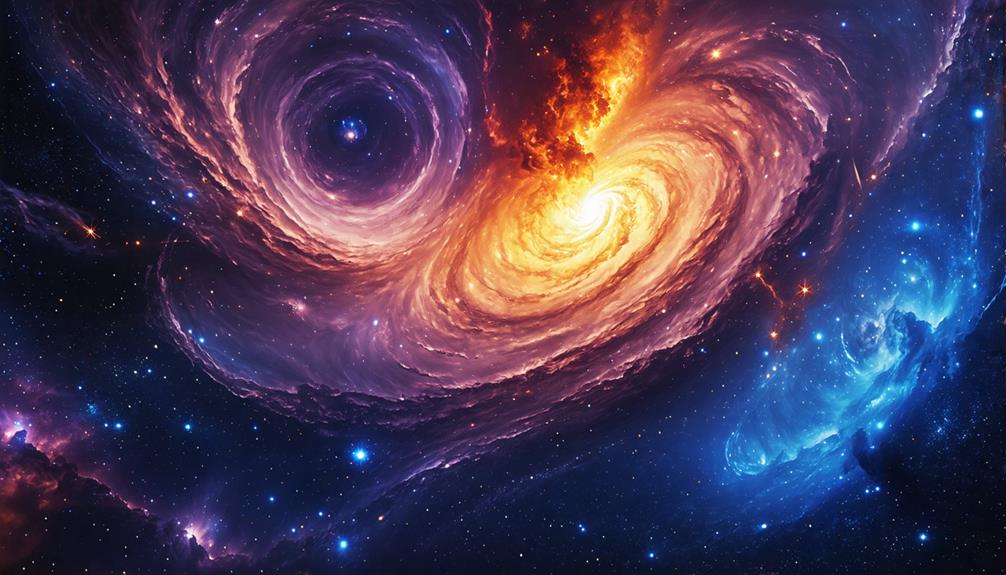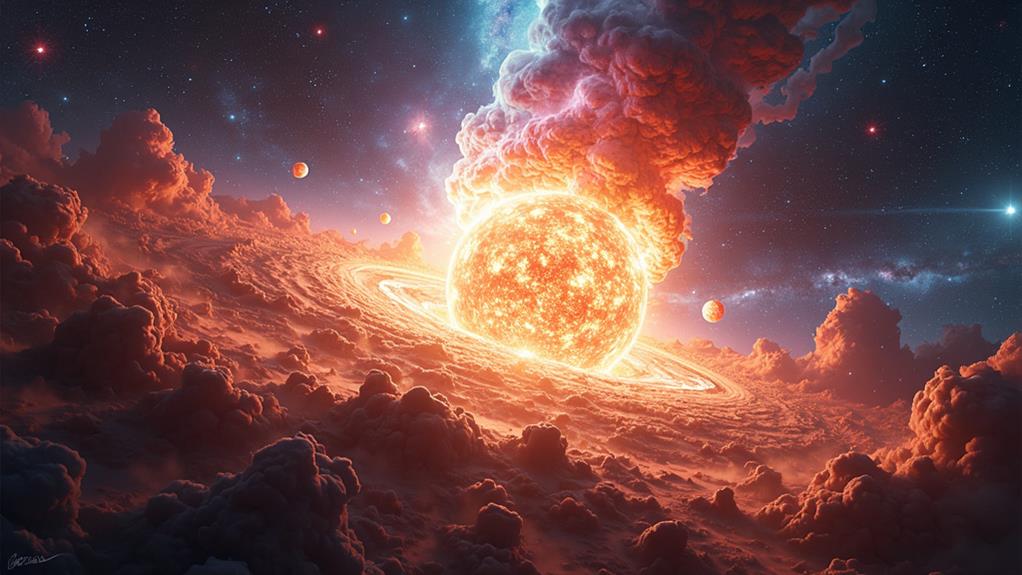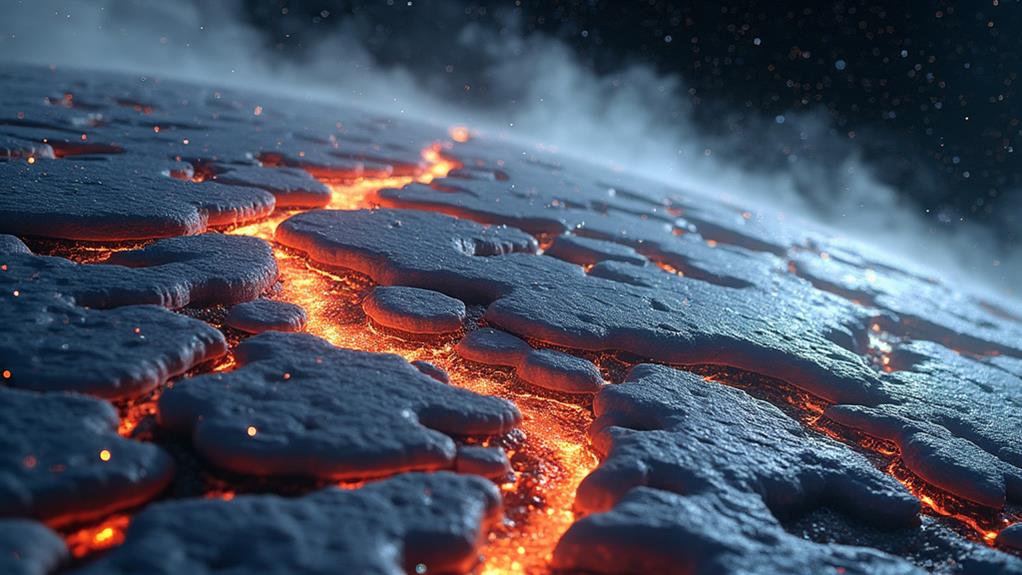Understanding Dark Matter and Dark Energy: The Invisible Forces Shaping the Universe

Dark matter and dark energy, though invisible and largely undetectable, are believed to govern the universe's structure and expansion. These mysterious forces constitute about 95% of the cosmos, influencing everything from galaxy formation to the universe's ultimate fate. As researchers employ advanced observational techniques, the questions surrounding these components grow more complex. What secrets do they hold, and how might unraveling them transform our understanding of reality?
Overview of Cosmic Components
The universe is composed of three primary components: normal matter, dark matter, and dark energy. Remarkably, dark matter and dark energy together constitute about 95% of the universe's total mass-energy content. Normal matter, the observable component, includes atomic particles like protons, neutrons, and electrons, making up roughly 5% of the universe. This means that the vast majority of the universe is composed of forms of matter and energy that are invisible and undetectable by traditional means.
Dark matter accounts for approximately 27% of the universe's mass. It does not interact with electromagnetic radiation, rendering it invisible to the entire electromagnetic spectrum. Nevertheless, its presence can be inferred through its gravitational effects on galaxies and large-scale structures. Dark matter is fundamental in shaping the cosmic web, influencing the formation and clustering of galaxies.
Dark energy, constituting about 68% of the universe, is hypothesized to drive the accelerated expansion of the cosmos. It appears to counteract gravitational forces, leading to the universe's continuous and accelerating growth. Understanding dark energy is crucial as it challenges our current models of the universe and presents profound implications for its ultimate fate.
Collectively, dark matter and dark energy pose significant questions about the universe's composition and evolution, prompting ongoing scientific research and exploration. A comprehensive understanding of these components is essential for appreciating the complex dynamics governing our vast universe.
The Nature of Dark Matter

Understanding dark matter is crucial, as it constitutes approximately 27% of the universe's mass-energy content and significantly influences the formation and evolution of cosmic structures. This enigmatic substance is not directly observable; it neither emits, absorbs, nor reflects light, making its presence known only through its gravitational effects on visible matter. For example, the consistent orbital speeds of stars within galaxies indicate the existence of unseen mass, pointing to dark matter's essential role in galaxy formation.
A compelling piece of evidence for dark matter arises from gravitational lensing, where light from distant celestial objects bends due to the gravitational fields generated by dark matter in galaxy clusters. Researchers are delving into the nature of dark matter, investigating exotic particles such as WIMPs (Weakly Interacting Massive Particles) and axions, which might explain why dark matter does not interact with normal matter in ways that are easily detectable.
While dark energy and the cosmological constant are distinct phenomena, understanding dark matter enhances our comprehension of the complex forces shaping the universe. As scientists continue to explore the nature of dark matter, new discoveries may fundamentally alter our understanding of the cosmos.
Exploring Dark Energy

Dark energy, accounting for approximately 68% of the universe's mass-energy content, is crucial in driving the accelerated expansion of the cosmos. This mysterious phenomenon was first suggested in the late 1990s through observations of distant Type Ia supernovae, which revealed that the universe's expansion is accelerating. Here's a closer look at dark energy's impact:
- Accelerated Expansion: It drives galaxies apart, causing the universe to expand at an increasing rate.
- Repulsive Gravitational Effect: Unlike gravity, which pulls matter together, dark energy exerts a force that counteracts gravitational attraction.
- Cosmological Constant: Initially introduced by Einstein, this is a leading theory explaining the nature of dark energy.
- Mysteries in Modern Cosmology: Despite its importance, dark energy remains one of the biggest enigmas in understanding the universe's structure and dynamics.
Understanding dark energy is essential for comprehending the universe's evolution and future. As researchers delve deeper, they aim to uncover the secrets behind this elusive force shaping our cosmos.
Scientific Research and Discoveries

Exploring the latest advancements in scientific research reveals groundbreaking projects like the Dark Energy Spectroscopic Instrument and the Next Generation Giant Magellan Telescope, which are expanding our understanding of the cosmos. Recent discoveries from NASA's Chandra X-ray Observatory and the Sloan Digital Sky Survey are transforming our knowledge of dark matter and dark energy. These initiatives are crucial in unraveling the fundamental mysteries that shape our universe.
Current Research Initiatives
Exploring the mysteries of dark matter and dark energy is driving groundbreaking research initiatives that promise to deepen our understanding of the universe. Here are some key projects currently underway:
- Dark Energy Spectroscopic Instrument (DESI): This five-year survey is mapping the large-scale structure of the universe, covering one-third of the sky and spanning 11 billion years of cosmic history.
- Giant Magellan Telescope (GMT): Currently under construction, the GMT aims to enhance our understanding of dark energy and dark matter by observing large and faint dwarf galaxies.
- Sloan Digital Sky Survey (SDSS): For over twenty years, SDSS has provided invaluable datasets that support research on dark matter and dark energy across various astronomical fields.
- CERN Experiments: Ongoing efforts at CERN focus on generating dark matter particles in the lab, helping researchers understand their properties and interactions with ordinary matter.
Additionally, the AbacusSummit project represents the largest suite of cosmological N-body simulations, specifically designed to analyze dark energy's impact on cosmic structures. Each of these initiatives plays a crucial role in unraveling the secrets of our universe.
Recent Scientific Discoveries
Recent findings from the Dark Energy Spectroscopic Instrument (DESI) are transforming our understanding of the universe's large-scale structures and the role of dark energy in cosmic evolution. By mapping one-third of the sky, scientists have identified billions of celestial objects, enhancing our comprehension of dark matter and its influence on the Milky Way. This discovery underscores the complex relationship between galaxies and the mysterious substances that dominate our universe.
Investigations into gravitational lensing have uncovered new lenses that offer insights into ancient galaxies and the distribution of dark matter. These observations not only deepen our understanding of cosmic history but also challenge existing theories about the interaction of these forces. Additionally, ongoing experiments at CERN aim to generate dark matter particles in the lab, striving to elucidate the nature of this elusive substance.
Through these groundbreaking discoveries, scientists are assembling the puzzle of dark energy and dark matter. As research advances, our understanding of the universe's fabric and the forces shaping it continues to evolve, heralding an exciting era in astrophysics. These developments promise to unveil more secrets of the cosmos, making it a thrilling time to follow advancements in this field.
Implications for Cosmology

The integration of dark matter and dark energy into cosmological models fundamentally reshapes our understanding of the universe's structure and evolution. These components challenge existing gravitational theories and cosmic dynamics, leading to several key implications:
- Dark Matter's Role: The gravitational effects of dark matter reveal the unseen mass that influences galaxy rotation and structure formation, guiding our understanding of cosmic architecture.
- Accelerated Cosmic Expansion: Dark energy, constituting approximately 68% of the universe, explains the accelerating expansion observed since the late 1990s, raising profound questions about the universe's ultimate fate.
- Model Revisions: The incorporation of dark matter and dark energy necessitates substantial updates to cosmological models, enhancing our comprehension of the universe's fundamental mechanics.
- Future Research Directions: Continued investigation into dark matter and dark energy is crucial for uncovering new insights into the forces driving cosmic evolution, offering a clearer picture of the universe's past and future.
These implications significantly alter our perception of the universe, underscoring the need for ongoing exploration into these elusive components.
Future Directions in Astrophysics

Future astrophysics research will focus on uncovering the nature of dark matter and dark energy, driving innovations in observational techniques and theoretical frameworks. Significant advancements are anticipated at facilities like CERN, where scientists aim to identify dark matter particles. This research could reshape our understanding of the universe's fundamental composition.
Upcoming observational instruments, such as the Giant Magellan Telescope and the James Webb Space Telescope, will enhance our grasp of dark energy and its role in cosmic expansion. By observing distant galaxies and supernovae, these telescopes will provide valuable data to elucidate dark energy's influence on cosmic evolution.
Moreover, the Dark Energy Spectroscopic Instrument (DESI) will conduct an extensive five-year survey to map large-scale structures, unveiling new aspects of dark energy. Interdisciplinary collaborations among physicists, astronomers, and cosmologists will be crucial in developing new theoretical models that reconcile dark energy with existing gravitational theories.
Conclusion
Understanding dark matter and dark energy is essential for comprehending the universe. These invisible forces shape cosmic structures and influence the universe's expansion. As you explore ongoing research and discoveries, you'll witness how scientists are unraveling their mysteries. This journey into the fundamental components of the cosmos promises exciting revelations, guiding future astrophysics and deepening your appreciation of the universe's intricate dynamics. Keep looking up; there's much more to uncover!




